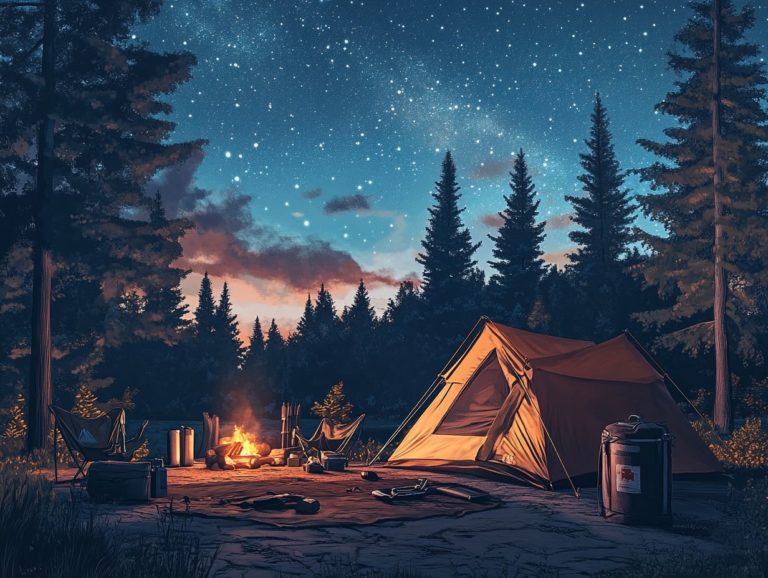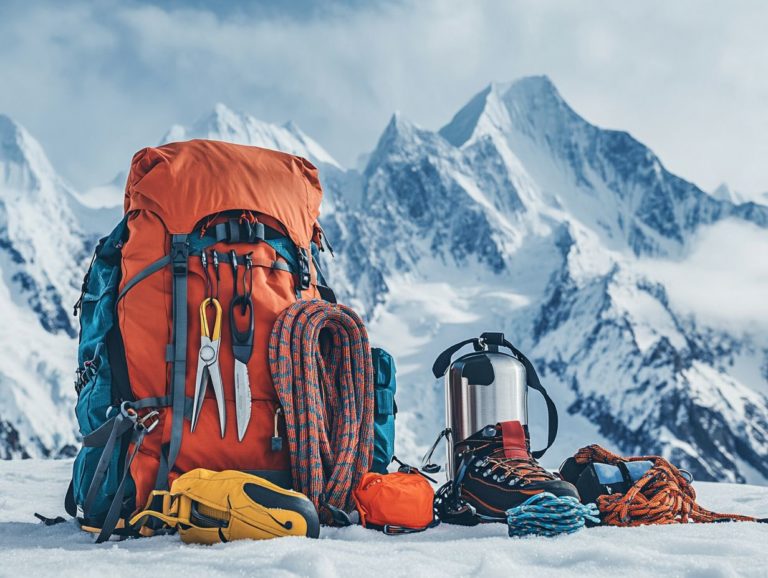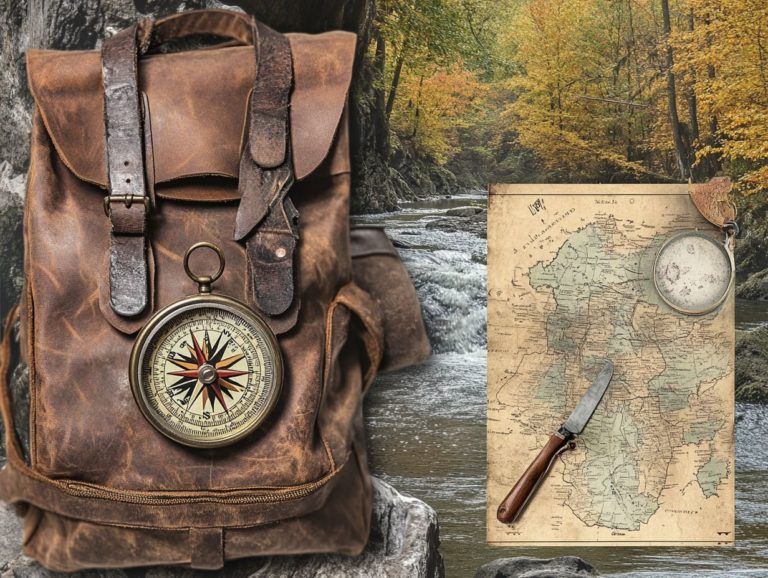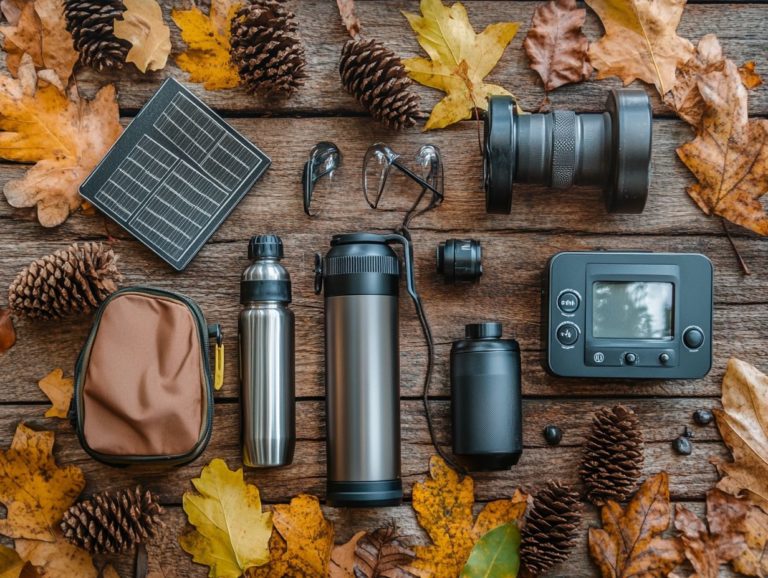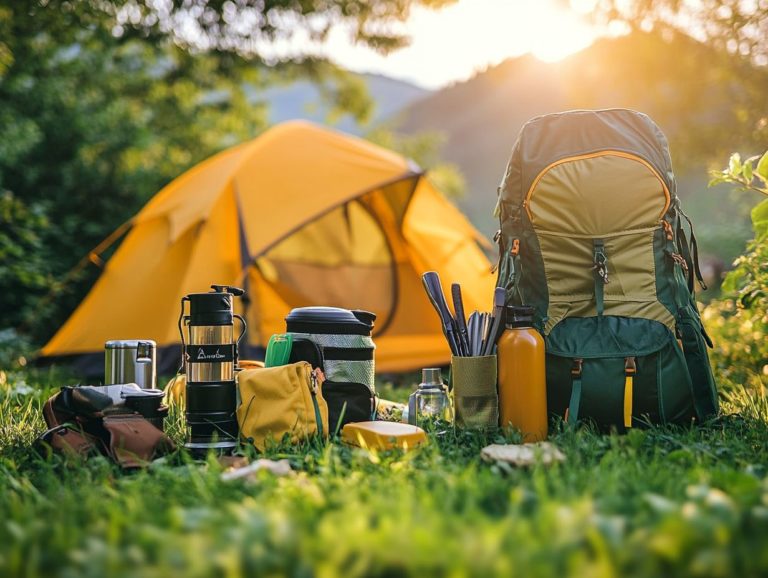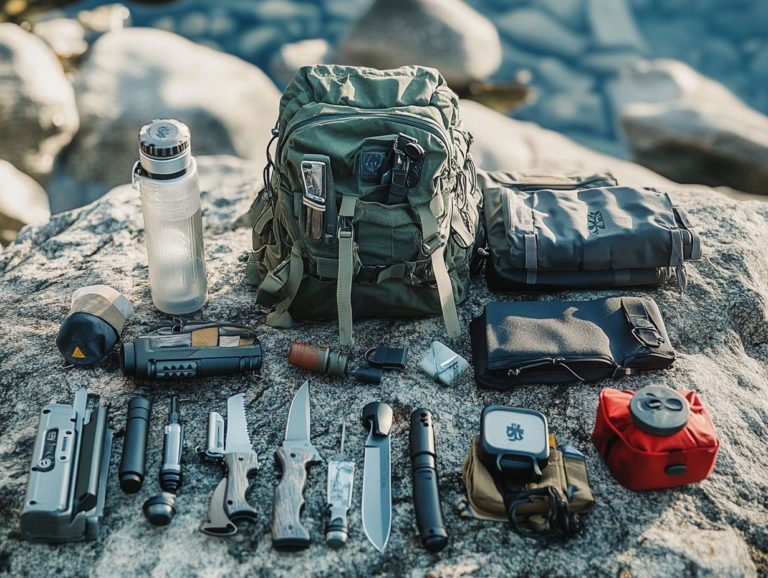Understanding Different Types of Survival Gear
Survival gear transcends being merely a collection of tools; it stands as your lifeline in unexpected circumstances.
Whether you re embarking on a wilderness adventure, bracing for natural disasters, or simply relishing outdoor activities, the right equipment can truly make a world of difference.
This guide delves into the essential survival items you should consider covering everything from shelter and food to navigation and first aid supplies.
You’ll discover tips for selecting the best gear tailored to your needs, along with expert advice on how to maintain it over time. Equip yourself to face any situation with confidence!
Contents
Key Takeaways:

- Pack essential items like shelter, food, water, and first aid supplies.
- Choose gear based on the situation to cover protection, navigation, and communication needs.
- When choosing survival gear, consider factors like durability, portability, and versatility to ensure you have the right tools for any emergency.
What is Survival Gear?
Survival gear is your go-to arsenal, filled with essential equipment tailored to assist you in emergency situations or wilderness adventures. It covers everything from building a shelter to finding food and administering first aid, ensuring your safety and survival in disaster-prone areas.
Whether it s a trusty fixed-blade knife or a portable water solution, grasping the components of a comprehensive survival kit is vital for anyone keen on outdoor exploration or emergency preparedness.
Your survival kit should feature signaling devices like whistles and mirrors, allowing you to alert rescuers when needed. Fire-starting tools are critical for warmth and cooking, making them a must-have. Additionally, water purification systems are crucial, ensuring you stay hydrated while navigating the wild. To ensure you choose the right equipment, it’s helpful to understand survival gear ratings. Finally, multi-tools pack several functions into one compact design, providing the versatility you need when space is limited.
Each category of survival gear plays a pivotal role in enhancing your ability to thrive in unpredictable conditions, making knowledge of these items not just practical, but essential for effective planning and execution in any survival scenario. Understanding what to include in your survival gear kit can greatly improve your preparedness.
Essential Items for Survival
In the realm of survival, understanding which essential items to pack in your kit can truly be the difference between life and death in the wilderness. Make sure to pack key components like a first aid kit, water purification tablets, and sturdy non-perishable food.
These items will significantly elevate your chances of making it through emergencies, providing you with the crucial tools to meet your basic needs.
To plan effectively, learn how to use these items, ensuring you re ready to tackle any unforeseen challenges that may arise.
Must-Have Gear for Any Situation
Now that you understand the essentials, let’s look at the must-have gear for survival. To embark on a successful adventure into the wilderness, it s essential to equip yourself with gear that can endure a variety of outdoor survival scenarios and emergencies.
Prioritize items like a fixed-blade knife, fire starter, and signaling devices in your survival kit, as they are instrumental for shelter construction, food preparation, and effective communication during emergencies. Understanding the types of survival knives is critical not only for disaster preparation but also enhances your wilderness survival expertise.
A fixed-blade knife is not just essential for cutting tasks; it also serves as a multi-purpose tool for building makeshift shelters, gathering firewood, and preparing food. Regarding fire starters, versatility is paramount; having both waterproof matches and magnesium flint ensures you can ignite a fire even in damp conditions, providing warmth and a means to cook.
Signaling devices such as whistles or reflective mirrors can significantly boost your visibility in distress situations, making it easier for rescuers to find you. Mastering the effective use of these tools can dramatically improve your survival odds, transforming a potentially crisis-ridden experience into something manageable.
Types of Survival Gear
Survival gear encompasses various categories, each carefully made to meet specific needs during outdoor adventures or emergencies. Learn about these categories: survival kits, portable equipment, and specialized tools like magnesium blocks and signaling devices. This knowledge enables you to choose the right gear tailored to your unique survival scenarios.
Whether you require lightweight options for easy transport or comprehensive survival bags for extended excursions, understanding the different types of climbing gear available is essential for effective disaster preparation.
Shelter and Protection
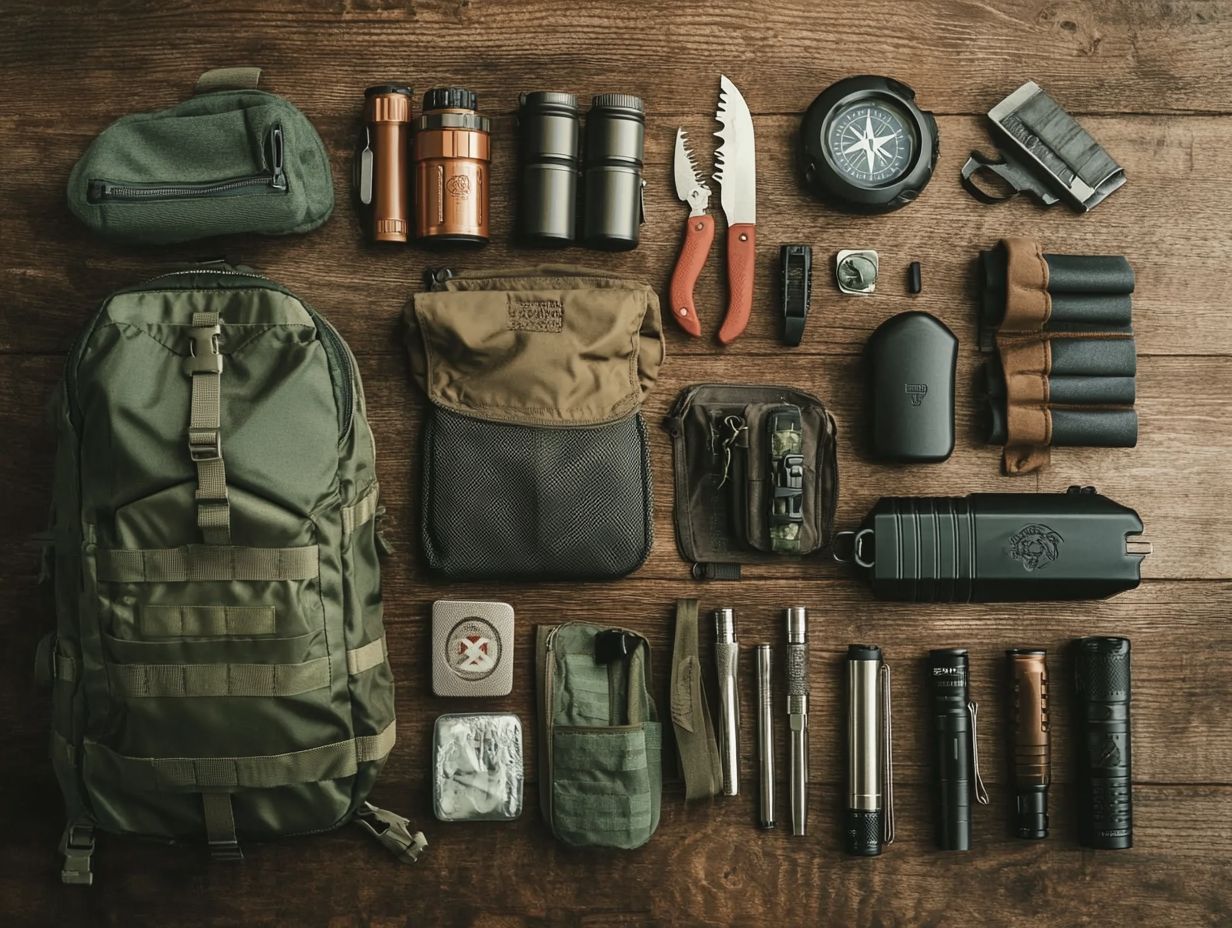
Shelter and protection are essential elements of your survival gear, offering refuge during adverse weather and emergencies. By utilizing materials like plastic sheeting, you can create makeshift shelters. Mastering various shelter-building techniques is vital for navigating outdoor survival scenarios.
It s crucial to have both the right gear and the knowledge to use it. A well-constructed shelter can mean the difference between life and death when facing elements like rain, wind, or extreme temperatures. Consider the terrain and available resources carefully to ensure your chosen location is safe and offers adequate insulation.
Techniques such as constructing a debris hut or leveraging natural features like fallen trees can significantly enhance your shelter’s effectiveness. Be proactive! Know your options like tarps and paracord they can save your life. Mastering these strategies equips you with critical skills, enabling you to face challenges with confidence.
Food and Water
Access to food and water is paramount in survival scenarios, making it essential for you to include reliable resources in your survival gear. A robust water bottle paired with water purification tablets, which kill germs in water, ensures you have access to potable water. Non-perishable food options provide the necessary sustenance during extended outings.
Understanding how to pack and utilize these survival supplies will significantly enhance your ability to endure in emergencies. Familiarizing yourself with various methods for water purification can boost your chances of survival. Boiling water is one of the oldest and most effective techniques, yet having a portable filter or a UV purifier provides convenience, especially when you re on the move.
Regarding food, opting for items like dehydrated meals, energy bars, and nuts guarantees nutrient-dense options that won t spoil easily. Being proactive about these essentials not only bolsters your confidence in critical situations but also helps maintain your energy levels and hydration both vital for making clear decisions when every moment counts.
Effective navigation and communication are essential skills in any survival scenario, enabling you to find your way and signal for help when needed. Equipping yourself with a range of navigation and communication tools can significantly enhance your chances of survival in the wilderness.
Compasses, GPS devices, and topographical maps will guide you through rugged landscapes, while signaling devices like whistles and mirrors can effectively alert rescuers to your location. When the unexpected happens, your ability to communicate emergencies promptly could be the difference between life and death.
Enrolling in a wilderness class not only equips you with practical skills but also provides invaluable insights on maximizing the use of these tools. This comprehensive approach to survival builds your confidence and ensures you are well-prepared for any unforeseen challenges that may arise.
First Aid and Medical Supplies
A well-stocked first aid kit is your essential companion in survival gear, crucial for handling injuries or medical emergencies that may arise while navigating the wilderness. Having key supplies like bandages, antiseptics, and medical tools can dramatically influence the outcome of an emergency situation.
By understanding how to effectively use these items, you enhance your overall survival strategy, ensuring you re ready for any unexpected medical hurdles.
To prepare for unforeseen circumstances, your comprehensive first aid kit should include essentials like:
- Tweezers for splinter removal
- Adhesive tape for securing bandages
- Scissors for cutting clothing or gauze
Incorporating gloves and a CPR mask promotes safety and hygiene when aiding others. Familiarizing yourself with the contents and their uses not only grants peace of mind but also ensures a swift and effective response during critical moments.
This reinforces the critical role that proper medical gear plays in both everyday life and thrilling adventures.
Personal Protection and Self-Defense
In any survival scenario, personal protection and self-defense are paramount. It’s crucial for you to include self-defense tools in your survival gear. A fixed-blade knife isn t just a handy tool for various tasks; it also serves as a vital means of personal safety against potential threats.
By understanding self-defense techniques (like basic martial arts) and incorporating them into your outdoor survival strategy, you enable yourself to face emergencies with confidence.
Equipping yourself with comprehensive knowledge about various survival gear options like pepper spray and personal alarms can significantly enhance your safety measures. Mastering self-defense techniques such as Krav Maga (a form of martial arts) or Brazilian Jiu-Jitsu (a combat sport) provides you with valuable skills for effectively responding to aggressive situations.
Tools like tactical flashlights not only improve visibility in the dark but can also act as a psychological deterrent to would-be attackers. Remember, preparedness is not just about physical tools; your mental readiness is equally vital when navigating threatening scenarios.
Tools and Equipment
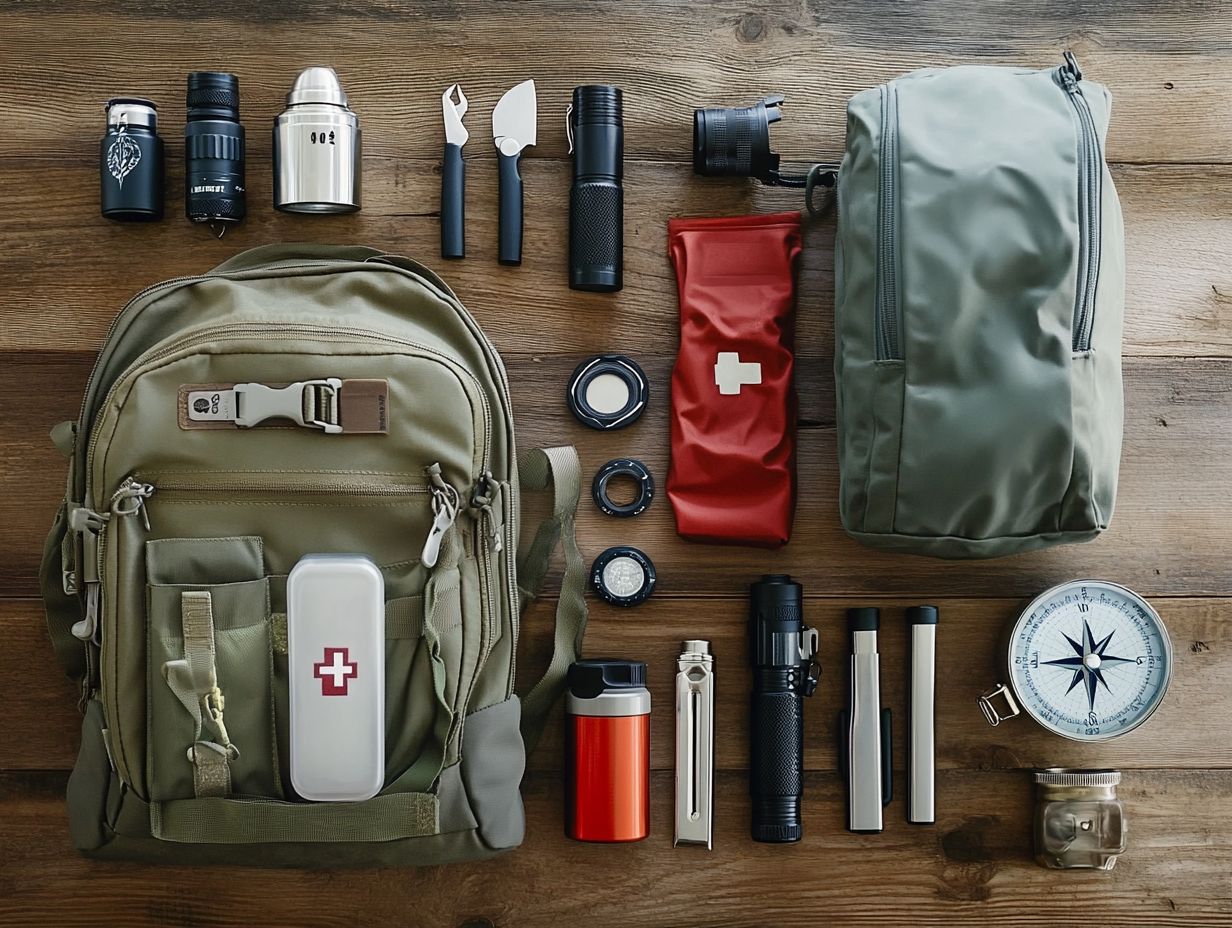
Survival tools and equipment are the backbone of any survival kit, enabling you to perform essential tasks efficiently in the wild. Lightweight gear designed for fire safety like magnesium blocks and fire starters plays a pivotal role in providing warmth and cooking food, both of which are critical for survival in outdoor environments.
By thoughtfully selecting and maintaining these tools, you can significantly enhance your effectiveness and confidence during wilderness survival situations. Beyond fire-starting tools, having a reliable multi-tool is critical, offering a range of functionalities from cutting rope to opening cans. To ensure you’re prepared, it’s also important to be aware of survival gear regulations.
Navigation aids, such as compasses and maps, are equally vital, ensuring you stay oriented and avoid the disorientation of getting lost. First-aid kits stocked with essential medical supplies are crucial for addressing injuries or health concerns that may arise.
Understanding the purpose and optimal use of each piece of equipment can drastically improve your chances of thriving in emergencies, making knowledge of survival gear just as important as having them within reach.
Emergency Signaling Devices
Emergency signaling devices are essential elements of your survival gear, meticulously crafted to alert rescuers and significantly improve your chances of being located in wilderness survival scenarios. These tools are true game-changers in life-threatening situations where every second counts.
Consider high-decibel whistles they’re favored for their straightforwardness and effectiveness. On the other hand, personal locator beacons (PLBs) take it up a notch by transmitting GPS signals for precise location tracking.
Additionally, brightly colored flags or reflective materials can capture attention during daylight hours, underscoring the crucial importance of visibility. Being well-versed in the various options available and implementing these strategies can greatly enhance your preparedness.
Always remember, possessing the right tools is crucial, but knowing when to use them can save your life!
Choosing the Right Survival Gear
Selecting the right survival gear is an important step in safeguarding your well-being and ensuring you re prepared for any emergency or outdoor escapade. Considerations such as the specific environment, your planned activities, and your personal skill level significantly influence which items should find a place in your survival kit.
Possessing adequate survival knowledge enables you to make good choices about your gear selection, ultimately boosting both your confidence and competence in wilderness survival situations.
Factors to Consider
When selecting your survival gear, you need to consider several factors to ensure best results and keeping yourself safe during emergencies.
The environment plays an important role in this decision-making process. Knowing the local climate whether it s prone to extreme temperatures, heavy rainfall, or snow will significantly influence the types of clothing and insulation you require. The geography, too, matters; whether you’re in an urban setting or deep in the wilderness will dictate the essential tools and supplies you need. Quality is paramount; unreliable gear can seriously undermine your safety in critical situations.
Your personal preferences are equally important. What works wonders for one person may not suit you at all, so it s wise to consider your individual skills and comfort levels when selecting essential items like:
- Survival knives
- First aid kits
- Water purification tools
This thoughtful approach ensures you develop a well-rounded and personalized survival strategy tailored just for you.
Maintaining and Replacing Survival Gear
Maintaining and replacing survival gear is crucial for ensuring your equipment remains effective when emergencies strike. Regularly checking, cleaning, and promptly replacing worn-out items play a significant role in your overall preparedness.
Learn the best maintenance practices and recognize when to replace specific components of your survival kit. Understanding the different types of survival kits can elevate your confidence and effectiveness in wilderness survival situations.
Tips for Long-Term Use and Replacement
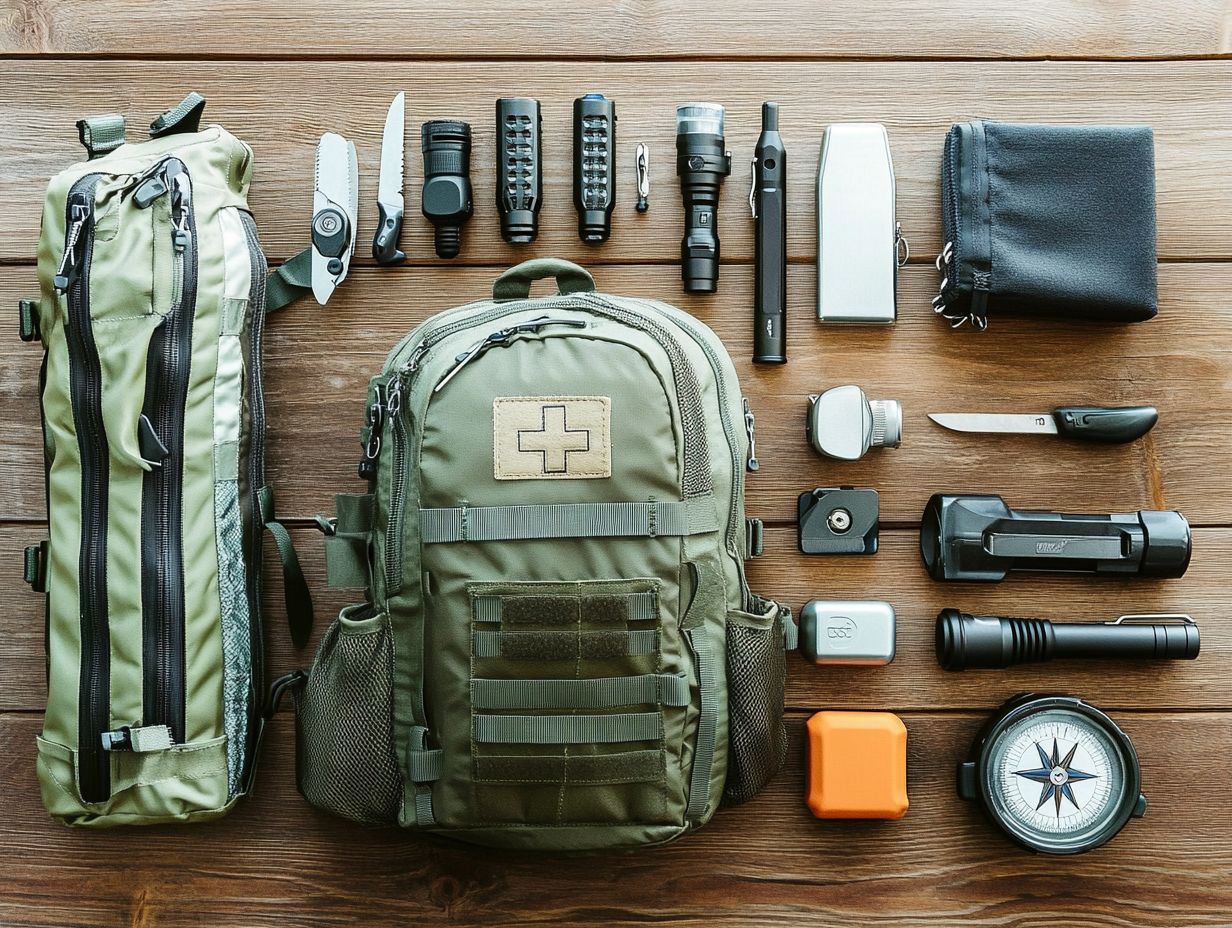
To ensure the longevity of your survival gear, it’s essential to implement effective strategies for long-term use and timely replacement. Regularly inspecting your items, keeping a detailed list of your gear, and being aware of replacement timelines for essential supplies can significantly enhance your emergency preparedness.
By prioritizing long-term maintenance, you not only extend the lifespan of your gear but also ensure you re always ready for any unforeseen circumstances. Don t wait until it s too late!
Establish a routine check-up schedule aim for biannual assessments to evaluate the functionality of everything in your kit. This should involve looking for signs of wear and tear, checking expiration dates on food and medicine, and ensuring that batteries in devices are charged or replaced.
Maintaining an organized inventory allows for quick updates and easy access during emergencies. Consider using a checklist format to track replacement items; this can simplify the process of restocking essential supplies and help you assess your overall readiness.
This proactive approach boosts your immediate preparedness and cultivates a mindset of resilience and adaptability.
Frequently Asked Questions
What is survival gear?
Survival gear refers to any equipment or tools specifically designed to help individuals survive in emergency or survival situations. This can include items such as first aid kits, water purification systems, and shelter materials.
What are the different types of survival gear?
There are many different types of survival gear, including emergency food and water supplies, navigation tools, shelter materials, and personal protective equipment. These can range from basic items like a compass and matches to more advanced gear like satellite phones and GPS devices.
Why is it important to understand the different types of survival gear?
Understanding the different types of survival gear can be crucial in emergency situations. Having the right gear can mean the difference between life and death, and knowing how to use each item properly can greatly increase your chances of survival.
How often should I check my survival gear?
It s recommended to check your survival gear at least twice a year to ensure everything is functional and in good condition.
Start preparing your survival kit today to ensure your safety tomorrow!
How do I choose the right survival gear for my needs?
Choosing survival gear? Think about your needs and the situations you might face.
Look into different brands to ensure you select high-quality and reliable gear.
Is there specific training required for using survival gear?
It’s crucial to get proper training on how to use each item. This can include first aid, navigation classes, and survival skills courses.
Can I create my own survival gear?
You can make some survival gear, but investing in high-quality items is smarter. They re reliable when you need them most.
Having basic survival skills and DIY knowledge is a great idea for emergencies!

